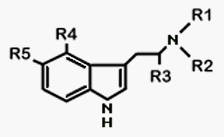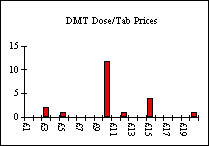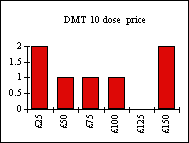|
|
Some articles have not been moved to our new site yet.
As a result you have been redirected to our old site.
If you wish to return to our new site - click here.
Tryptamines
& Phenethylamines
1 Introduction
- Tryptamines
1.1 Tryptamines
are a family of compounds structurally derived from
tryptamine, which consists of a double ring structure
and side chain. The family includes neurotransmitter
serotonin (5-hydroxy tryptamine) and hallucinogenic/psychedelic
drugs such as LSD, Psilocybin (magic mushrooms) -
both widely-used, and other, less common, synthetic
drugs such as dimethyl-tryptamine (DMT).
1.2 The
potency and duration of action for each member of
the family will vary according to nature, and position
of, the substituted side-groups on the benzene ring
(R4 & R5) or the amino-side chains (R1, R2 &
R3) - see fig 1
Fig
1 - Tryptamine chemical structure

1.3 The
most common tryptamine, after LSD and Psilocybin,
is DMT (nn-dimethyltryptamine = Shulgin T#4). This
was known as the "businessman"s trip"
when smoked (30-100mg) as it is short-acting with
a duration of less than one hour. DMT is inactive
orally unless combined with monoamine oxidase inhibitors.
Other tryptamines would most probably be sold to casual
users as DMT, but may be properly represented to cognoscenti
interested in experimenting with effects of different
compounds.
2 Tryptamine
Dosage & Duration
2.1 Many
tryptamine compounds have been studied by Alexander
Shulgin, who has catalogued the information on the
various analogues, including subjective bioassays
of different dosages and routes of administration,
using himself as a guinea-pig.
|
Table
1 - Dosages & duration of Tryptamine drugs
|
|
Drug
|
Type
|
Dosage/Duration
(Shulgin)
|
|
nn-dimethyltryptamine
|
Tryptamine
|
T#4 dosage
30-100mg smoked, inactive orally, duration up to
1 hr
|
|
Acetoxy-NN-dimethyltryptamine
(Bufotenin)
|
Tryptamine
|
T#19
dosage 8-16mg i.v.
Duration
1-2 hrs
|
|
Acetoxy-nn-di-isopropyltrytamine
|
Tryptamine
|
T#37
(5-MeoDIPT) dosage 6-12mg orally
"Positive
LSD-like psychedelic", duration 4-8hr
|
|
Lysergide
(:LSD)
|
Tryptamine
type
|
T#26
dosage 60-200µg orally,
Duration
8-12hrs
|
|
Methoxy-nn-dimethyltryptamine
|
Tryptamine
|
T#38:
5-MeO-DMT - dosage 6-20mg smoked, 2-3mg iv, duration
1-2hrs
Also
T#39: 4-MEO-DMT (note: unstable - DET homologue
inactive <30mg smoked)
|
|
NN-dipropyltryptamine
|
Tryptamine
|
T#9:
dosage 100-250mg orally, 100+mg smoked, 12-36mg
iv, 80-100mg i.m.
Duration
2-4hrs
|
|
Psilocybe
Mushrooms
|
Tryptamine
|
T#18:
Psilocybin - 10-20mg orally
Duration
3-6hrs
|
2.2 Intravenous
dosages tended to be 3-7 times lower than the smoked
equivalent. Several compounds are inactive orally
(unless combined with enzyme blockers), and must be
smoked or injected to have effects. Oral dosages tend
to be 2-3x higher than smoked dosages in other compounds.
3 Availability/Prevalence
of DMT use.
3.1 DMT
is used by a small minority of drug users, but has
been appearing more frequently on the UK market since
1998. Approximately 1% of recreational drug users
(maybe 20-30000 people) have tried it, or believe
they have done so. Far more would do so if they had
the opportunity, as it would appeal to users of LSD
and magic mushrooms.
|
Table
2 - Incidence of reported DMT use in the UK
(IDMU 1984-00)
|
|
Year
|
No.
of Respondents Reporting DMT use
|
Sample
size
|
%
|
|
1984
|
3
|
607
|
0.49%
|
|
1997
|
5
|
1136
|
0.44%
|
|
1998
|
26
|
1153
|
2.25%
|
|
1999
|
23
|
2173
|
1.06%
|
|
2000
|
25
|
2352
|
1.06%
|
|
Total
|
82
|
7421
|
1.10%
|
3.2 Of
those who reported how often they had used DMT, the
majority had done so on an expermental basis (less
than 10 times), although four considered themselves
regular users. No-one has claimed to use DMT on a
daily basis.
|
Table
3 - Frequency of DMT Use
(IDMU 1997-00)
|
|
Frequency
of use
|
Number
of respondents
|
|
Experimental
|
40
|
|
Occasional
|
9
|
|
Regular
|
4
|
|
Daily
|
0
|
|
Not
Stated
|
29
|
|
Total
|
82
|
4 Phenethylamines
4.1 The
best known phenethylamine is methylenedioxymethylamphetamine
(MDMA), commonly known as ecstasy, which is widely-used
throughout the UK. Many other substances have been
found in tablets sold as ecstasy, including MDEA,
MBDB and a wide range of other substances, although
MDMA and MDEA are the most common.
4.2 A
small number of other phenethylamines have "niche"
markets in the UK in their own right, of which 2-CB
is the most commonly reported in IDMU surveys.
|
Table
4 - Frequency of 2-CB use (IDMU 1997-00)
|
|
Frequency
of use
|
Number
of respondents
|
|
Exp
|
19
|
|
Occ
|
3
|
|
Reg
|
5
|
|
Daily
|
0
|
|
Not
Stated
|
24
|
|
Total
|
51
|
4.3 2-CT2:
There is only one previous survey report of a user
knowingly having used 2-CT2 (2,5-dimethoxy-4-ethylthiophenethylamine)
in the UK. Shulgin P#40 quotes an oral dosage range
of 12-25mg, with a duration of 6-8hrs
5 Tryptamine
& Phenethylamine Street Prices UK 1997-2000
5.1 The
only synthetic tryptamine where prices have been reported
with any frequency is DMT (dimethyltryptamine). This
has been a write-in option under "other psychedelic"
or "other drug" in IDMU surveys since 1997,
involving a combined total of over 7000 drug users.
All price reports since 1997 have been combined with
the following results:
|
Table
5 - UK DMT Prices (1997-2000)
|
|
DMT
Unit
|
Number
reporting
|
Average
Price
|
|
Dose/Tab
|
22
|
£10.52
|
|
10
doses
|
7
|
£81.43
|
|
Gram
|
7
|
£225.00
|
5.2 2-CB
prices: There were 24 price reports for 2-CB,
an alternative phenethylamine type drug, with an average
per dose of £4.07 (24 reports), and £27.50 for 10
doses (2 reports of £25 and £30 respectively). There
was only one price report for 2CT-2, which quoted
£15 but no units were indicated.
5.3 The
ranges of reported prices for DMT and 2-CB from IDMU
surveys between 1997 and 2000 are shown in fig 7 overleaf.
Fig
2 - Distribution of reported UK DMT/2-CB prices 1997-2000
 
|
All contents of this web
site & any links to other sites etc, is for educational
& research purposes. IDMU at no time seeks to encourage
illegal activities. All sections of this site and its contents
are protected under copyright laws. © IDMU
Ltd 1994 - 2008
|
|
|
|